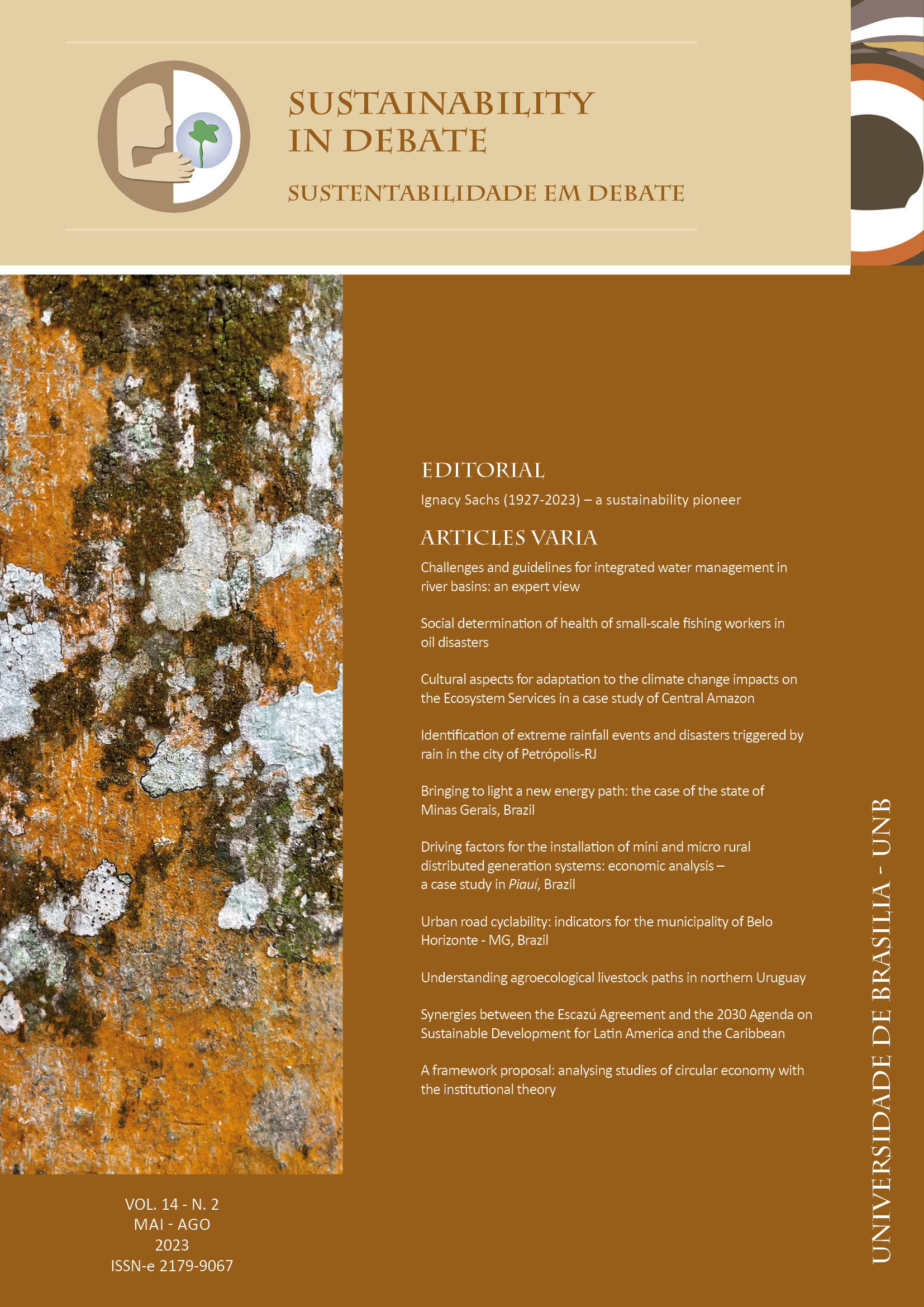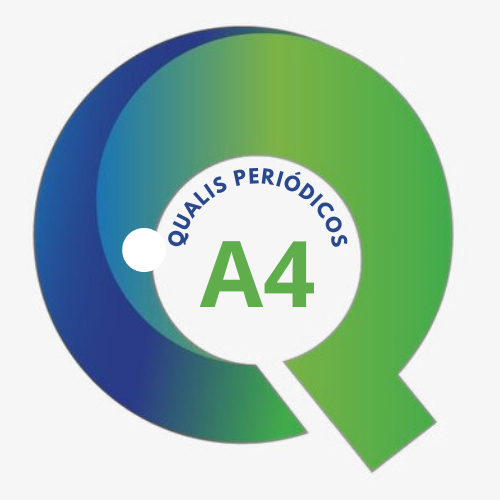Ciclabilidade viária urbana: indicadores para o município de Belo Horizonte- MG, Brasil
DOI:
https://doi.org/10.18472/SustDeb.v14n2.2023.48691Palavras-chave:
Ciclabilidade, Mobilidade Urbana, Transporte Ativo, Transporte não MotorizadoResumo
A maneira como as pessoas se deslocam nas grandes cidades brasileiras é reflexo do complexo processo de produção e apropriação do espaço urbano, que no sistema de transportes se caracteriza pela crescente taxa de motorização individual e na precariedade da prestação de serviços de transportes públicos. O objetivo geral deste paper é avaliar o nível de ciclabilidade viária do município de Belo Horizonte/Minas Gerais/Brasil, tendo como base a proposição e análise de indicadores para avaliar o grau de adequação das vias urbanas ao uso da bicicleta como modo de transporte. De um modo geral, os resultados obtidos indicam que significativa parcela das vias de Belo Horizonte apresenta bons níveis de ciclabilidade. Esse desempenho costuma contrariar o senso comum que tende a considerar o município, dada sua topografia e clima, como inapropriado ao uso da bicicleta como modo de transporte. Na verdade, Belo Horizonte possui elevado potencial ciclável ainda muito subutilizado, especialmente se existir um investimento na ampliação da infraestrutura viária exclusiva/preferencial.
Downloads
Referências
BAROUCHE, T. O. O caos da mobilidade urbana: uma análise do atual regime de financiamento do transporte público municipal e a necessidade da construção de novos paradigmas. Publicação do XXIII ENCONTRO NACIONAL DO CONPEDI/UFSC, 2014, p. 404-425.
BOTMA, H. Method to Determine Level of Service for Bicycle Paths and Pedestrian-Bicycle Paths. In Transportation Research Record 1502, TRB, National Research Council, Washington, D.C., 1995.
BRASIL. Lei 12.587, de 3 de janeiro de 2012. Institui as diretrizes da Política Nacional de Mobilidade Urbana e dá outras providências. Diário Oficial da União, Brasília, 2012.
BUEHLER, R.; DILL, J. Bikeway networks: a review of effects on cycling. Transport Reviews, 2016, p. 1-19. Available at: https://doi.org/10.1080/01441647.2015.1069908
CARDOSO, L. Transporte público, acessibilidade urbana e desigualdades socioespaciais na Região Metropolitana de Belo Horizonte (Tese de Doutorado) – Instituto de Geociências, Universidade Federal de Minas Gerais, Belo Horizonte, 2007.
DAVIS, J. Bicycle Safety Evaluation. Auburn University, City of Chattanooga, and Chattanooga–Hamilton County Regional Planning Commission, Chattanooga, Tenn, 1987.
DILL, J.; CARR, T. Bicycle Commuting and Facilities in Major US Cities: if you build them, commuters will use them – Another Look, Washington, DC: Transportation Research Board, 2003.
DIXON, L. B. Bicycle and Pedestrian Level-of-Service Performance Measures and Standards for Congestion Management Systems. In Transportation Research Record 1538, TRB, National Research Council, Washington, D.C, 1996. Available at: https://doi.org/10.1177/0361198196153800101
DOWLING, R. G. et al. Report 616: multimodal level of service analysis for urban streets multimodal level of service analysis for urban streets. Transportation Research Board of the National Academies, Washington, D.C, 2008.
ELIOU, N.; GALANIS, A.; PROIOS, A. Evaluation of the bikeability of a Greek city: case study "city of volos". Wseas Transactions on Environment and Development, v. 5, n. 8, 2009, p. 545–555.
FHWA. Reasons Why Bicycling and Walking Are and Are Not Being Used More Extensively as Travel Modes. Federal Highway Administration, US Department of Transportation McLean, VA, 2002.
FONSECA, D. F.; LOBO, C.; GARCIA, R. A. Imposto predial e territorial urbano: uma metodologia de ajuste tributário para Belo Horizonte/MG. Urbe. Revista Brasileira de Gestão Urbana, v. 9, p. 513-526, 2017. Available at: https:// doi.org/10.1590/2175-3369.009.003.AO10
FORESTER, J. Effective cycling, 6th ed. The MIT Press, Cambridge, 1993.
FULLER, D. et al. Impact Evaluation of a Public Bicycle Share Program on Cycling: a case example of BIXI in Montreal, Quebec. American Journal of Public Health, v. 103, n. 3, e85–e92, 2013. Available at: https://doi. org/10.2105/AJPH.2012.300917
HANSEN, W. G. Accessibility and residential growth. Diss. Massachusetts Institute of Technology, 1959.
JENSEN, S. Pedestrian and Bicyclist Level of Service on Roadway Segments. In Transportation Research Record. Journal of the Transportation Research Board, N.. 2031. Transportation Research Board of the National Academies, Washington, D.C, 2007. Available at: https://doi.org/10.3141/2031-06
JONES, S. R. Accessibility measures: a literature review. Transport and Road Research Laboratory. Laboratory Report 967, 1981.
KRENN, P. J.; OJA, P.; TITZE, S. Development of a Bikeability Index to assess the bicycle friendliness of urban environments. Open J. Civil Eng. v. 5, 2015, p. 451–459. Available at: https://doi.org/10.4236/ojce.2015.54045
LANDIS, B. W. Bicycle Interaction Hazard Score: a theoretical model. In Transportation Research Record 1438, TRB, National Research Council, Washington, D.C, 1994.
LESSA, D. A. et al. Accessibility and urban mobility by bus in Belo Horizonte/Minas Gerais - Brazil. Journal of Transport Geography, v. 77, 2019, p. 1-10. Available at: https://doi.org/10.1016/j.jtrangeo.2019.04.004
LOTT, D. Y.; TARRDIFF, T.; LOTT, D. F. Bicycle Transportation for Downtown Work Tripes: a case study in Davis, California. Transportation, Research Record: Jornal of the Transportation, Washington, DC, 1977.
MANUM, B. et al. Modelling Bikeability: space syntax based measures applied in examining speeds and flows of bicycling in Gothenburg. Proceedings of the 11th Space Syntax Symposium, 2017.
MARTENS, K. The bicycle as a feedering mode: experiences from three European countries. Transportation Research. Part D, 2004, p. 281-294. Available at: https://doi.org/10.1016/j.trd.2004.02.005
NIELSEN, T. A. S.; SKOV-PETERSEN, H. Bikeability – Urban structures supporting cycling. Effects of local, urban and regional scale urban form factors on cycling from home and workplace locations in Denmark. Journal of Transport Geography, 2018, p. 36-44. Available at: https://doi.org/10.1016/j.jtrangeo.2018.04.015
NOBREGA, R. A. A. Mapa de declividade da malha viária de Belo Horizonte. 2016.
NORDSTRÖM, T.; MANUM, B. Measuring bikeability: space syntax based methods applied in planning for improved conditions for bicycling in Oslo. In: Proceedings of the 10th International Space Syntax Symposium, 2015.
PEREIRA, R. et al. O uso da sintaxe espacial na análise do desempenho do transporte urbano: limites e potencialidades. Texto para Discussão, n. 1630. Rio de Janeiro: Ipea, 130, 2011.
PEZZUTO, C.; SANCHES, S. Identificação dos fatores que influenciam o uso da bicicleta, visando ao direcionamento de programas cicloviários. Revista dos Transportes Públicos – ANTP, Ano 25, 2003.
PUCHER, J.; BUEHLER, R. Making cycling irresistible: lessons from the Netherlands, Denmark and Germany. Transport Reviews, v. 28, n. 4, 2008, p. 495–528. Available at: https://doi.org/10.1080/01441640701806612
RIETVELD, P.; DANIEL, V. Determinants of bicycle use: do municipal policies matter? Transp. Res. Part. A Policy. Pract., v. 38, 2004, p. 531–550. Available at: https://doi.org/10.1016/j.tra.2004.05.003
RYBARCZYK, G.; WU, C. Bicycle facility planning using GIS and multi-criteria decision analysis. Applied Geography, v. 30, n. 2, 2010, p. 282–293. Available at: https://doi.org/10.1016/j.apgeog.2009.08.005
SENER, I.; ELURU, N.; BHAT, C. Who Are Bicyclists? Why and How Much Are They Bicycling? Transportation research record, v. 2134, 2009, p. 63–72. Available at: https://doi.org/10.3141/2134-08
SISSON, S. B. et al. Suitability of Commuting by Bicycle to Arizona Elementary Schools. American Journal of Health Promotion, v. 20, n. 3, 2006, p. 210–213. Available at: https://doi.org/10.4278/0890-1171-20.3.210
SORTON, A.; WALSH, T. Bicycle Stress Level as a Tool to Evaluate Urban and Suburban Bicycle Compatibility. In Transportation Research Record 1438, TRB, National Research Council, Washington, D.C, 1994.
SOUZA, P. B. Análise dos fatores que influenciam o uso da bicicleta para fins de planejamento cicloviário. Tese apresentada à Escola de Engenharia da Universidade de São Carlos, 2012.
SZYSZKOWICZ, S. S. Bikeability as an Indicator of Urban Mobility. Economic Analysis Directorate Transport Canada Place de Ville, Tower C Ottawa, 2018.
TRALHÃO, L. et al. Metodologia em ambiente SIG para localizar dispositivos de auxílio ao ciclista em cidades declivosas. Presented at the 2015. Coimbra, 2015.
TURNER, S.; SHAFER, S.; STEWART, W. Bicycle Suitability Criteria for State Roadways in Texas. Texas Transportation Institute, Texas A&M University System, College Station, 2012.
VASCONCELLOS, E. A. Transporte urbano, espaço e equidade. São Paulo: Fapesp, 1996.
VIOLA, P. D. et al. Potencial de viagens por bicicleta em Belo Horizonte: uma proposta metodológica com base na Pesquisa Origem e Destino de 2012. Revista Transporte y Territorio, n. 20, p. 370-386, 2019. Available at: https:// doi.org/10.34096/rtt.i20.6397
WAHLGREN, L. Exploring bikeability in a metropolitan setting: stimulating and hindering factors in commuting route environments. School of Health and Medical Sciences: Örebro University, 2011. Available at: https://doi. org/10.1186/1471-2458-12-168
WINTERS, M. Mapping bikeability: a spatial tool to support sustainable travel. Environment and Planning B: Planning and Design, v. 40, 2013, p. 865 – 883. Available at: https://doi.org/10.1068/b38185
Downloads
Publicado
Como Citar
Edição
Seção
Licença
Copyright (c) 2023 Sustainability in Debate

Este trabalho está licenciado sob uma licença Creative Commons Attribution-NonCommercial-NoDerivatives 4.0 International License.
A submissão de trabalho(s) científico(s) original(is) pelos autores, na qualidade de titulares do direito de autor do(s) texto(s) enviado(s) ao periódico, nos termos da Lei 9.610/98, implica na cessão de direitos autorais de publicação impressa e/ou digital à Revista Sustentabilidade em Debate do(s) artigo(s) aprovado(s) para fins da publicação, em um único número da Revista, autorizando-se, ainda, que o(s) trabalho(s) científico(s) aprovado(s) seja(m) divulgado(s) gratuitamente, sem qualquer tipo de ressarcimento a título de direitos autorais, por meio do site da Revista, para fins de leitura, impressão e/ou download do arquivo do texto, a partir da data de aceitação para fins de publicação. Portanto, os autores ao procederem a submissão do(s) artigo(s) Revista, e, por conseguinte, a cessão gratuita dos direitos autorais relacionados ao trabalho científico enviado, têm plena ciência de que não serão remunerados pela publicação do(s) artigo(s) no periódico.
A Revista encontra-se licenciada sob uma Licença Creative Commons Atribuição-NãoComercial-SemDerivações (Proibição de Realização de Obras Derivadas) 3.0 Brasil, para fins de difusão do conhecimento científico, conforme indicado no sítio da publicação, que permite o compartilhamento do texto e o reconhecimento de sua autoria e publicação original nesta revista.
Os autores têm permissão para assumir contratos adicionais separadamente, para distribuição não-exclusiva dos trabalhos publicados na Revista Sustentabilidade em Debate (por exemplo, em um capítulo de livro), desde que seja assinalado que os textos foram originalmente publicados nesta revista e que seja mencionado o DOI correspondente. Os autores têm permissão e são estimulados a publicar e distribuir o seu texto online, após a publicação (por exemplo, em repositórios institucionais ou nas suas páginas pessoais).
Os autores declaram expressamente concordar com os termos da presente Declaração de Direito Autoral, que se aplicará a submissão caso seja publicada por esta Revista.






